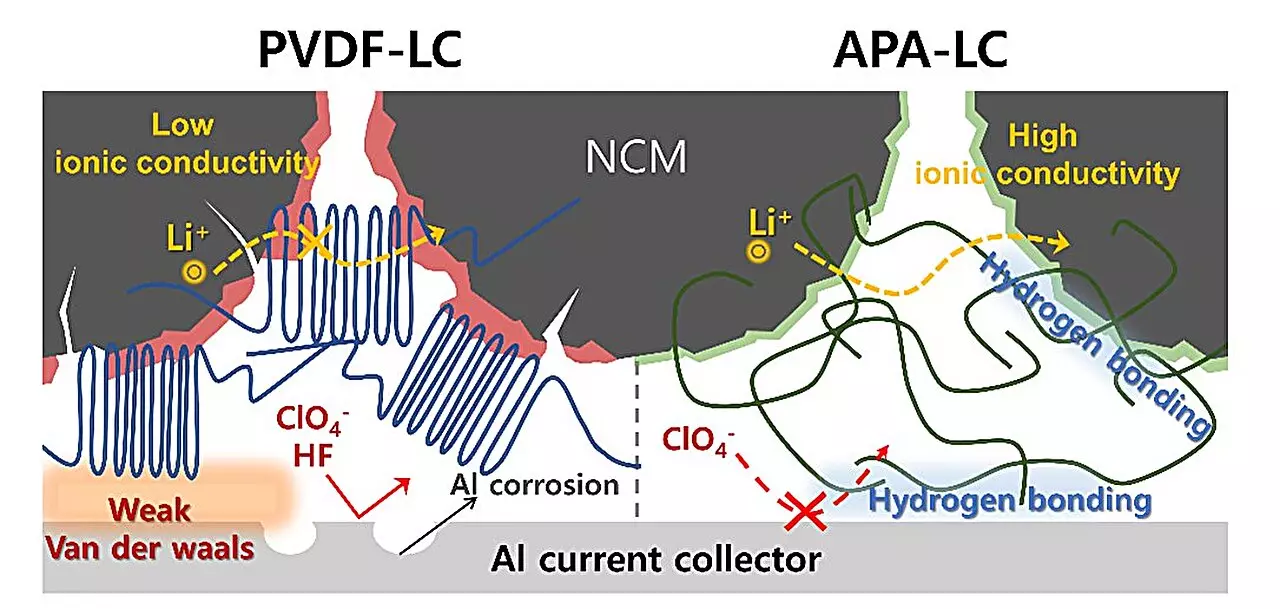The battery industry is at a crossroads as it grapples with urgent demands for greater sustainability and efficiency. Traditional lithium-ion batteries offer considerable performance but come with drawbacks that can no longer be overlooked, especially given the mounting environmental regulations. Researchers from POSTECH and Hansol Chemical have recently unveiled a pioneering solution aimed at transforming this landscape: a new battery system that replaces toxic fluorinated compounds with more sustainable alternatives. Their findings, reported in the Chemical Engineering Journal, highlight the critical intersection of technology and environmental responsibility.
At the heart of the standard lithium battery design is the reliance on polyvinylidene fluoride (PVDF) binders and lithium hexafluorophosphate (LiPF6) electrolytes. Though effective, these components pose significant environmental risks. The decomposition of PVDF can emit hazardous hydrogen fluoride (HF), a substance that not only poses health risks but also compromises battery performance and longevity. Additionally, given the European Union’s commitment to banning per- and polyfluoroalkyl substances (PFAS) by 2026, the traditional battery designs face an imminent threat of obsolescence. The urgency for researchers to pivot toward eco-friendly alternatives has never been clearer.
Addressing these challenges, the POSTECH-Hansol Chemical team has developed an innovative non-fluorinated electrolyte and binder system, dubbed APA-LC. Utilizing lithium perchlorate (LiClO4) as the electrolyte and an aromatic polyamide (APA) as the binder, this new system eliminates fluorinated substances entirely. This is not just a minor tweak; rather, it signifies a critical shift in the design philosophy of battery chemistry. The APA binder plays a crucial role in ensuring robust connections between the cathode’s active materials and the aluminum current collector, substantially mitigating electrode corrosion—a major issue in conventional systems.
The performance of the APA-LC system notably exceeds that of its traditional counterparts. In extensive tests, it demonstrated superior oxidation stability and capacity retention, outperforming the conventional PVDF-LP system by maintaining 20% higher capacity after 200 cycles at a fast charge/discharge rate. In practical terms, this translates into a longer lifespan and improved reliability, both of which are essential attributes for the increasing demands of modern applications. The development of a high-capacity 1.5 Ah pouch cell showcases the potential for scaled applications, marking a significant leap forward for commercial viability.
Professor Soojin Park from POSTECH expressed optimism about the transformative implications of the APA-LC system for the battery industry, asserting that the strategy does more than just replace existing technologies; it effectively increases sustainability and aligns with global regulatory frameworks. This innovation positions the research teams at the forefront of a crucial transition towards eco-friendly batteries, paving the way for broader adoption in diverse sectors.
Young-Ho Yoon from Hansol Chemical reinforced the significance of this breakthrough, noting its strategic importance in securing a strong position within the burgeoning global market for cathode binders, projected to reach an astounding value of KRW 1.7 trillion by 2026. The introduction of non-fluorinated materials not only meets regulatory demands but also sets a precedent for future developments in the field.
The advent of the APA-LC system represents a momentous achievement in battery technology, providing a blueprint for future innovations that prioritize both performance and environmental responsibility. The collaborative effort between academic institutions and industrial partners exemplifies how focused research can dissolve barriers in technology adoption, while also adhering to stringent ecological standards. As the world moves toward a greener future, the success of this non-fluorinated battery technology could serve as a cornerstone for sustainable energy sources that are efficient, safe, and environmentally friendly. The implications extend far beyond batteries, echoing the broader necessity for industries to re-evaluate their approaches in a world increasingly defined by ecological considerations.


Leave a Reply